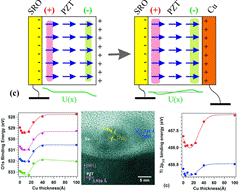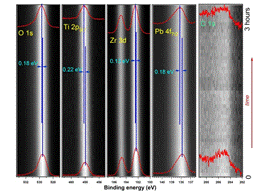Invité par Nick BARRETT,
Abstract :
X-ray photoelectron spectroscopy (XPS) is widely utilized for the characterization of surfaces and interfaces, owing to its chemical and surface sensitivity. Ferroelectrics are intensely studied materials nowadays, but only recently models were proposed for charge compensation of the depolarization field [1]. Recently it was shown that high resolution XPS is able to quantify band bending at surfaces and interfaces [2-6]. Core level shifts are sensitive to the conduction and valence band bending at interfaces, which is of particular interest for ferroelectrics (Fig. 1) and for metal/ferroelectric interfaces. In this work we will review recent results obtained by using XPS to quantify band bendings at metal-semiconductor interfaces [3], at free ferroelectric surfaces [2,4], and at metal-ferroelectric interfaces [5], evidencing new phenomena such as competing Schottky barrier and over-compensation by electrons provided by the metal (Fig. 2) [6], or preferential adsorption of polar molecules onto areas with well-defined out-of-plane polarization. New functionalities of ferroelectrics start to be exploited in surface chemistry and catalysis. Fig. 3 demonstrates the interplay between surface core level shifts and the molecular coverage for CO adsorbed on Pb(Zr,Ti)O3.

Figure 1: Band bendings at free ferroelectric surfaces and their effects on the core level shifts: (a) outwards polarization; (b) inwards polarization.

Figure 2: Depolarization mechanism proposed to explain the vanishing of the surface band bendings when Cu layers are grounded, together with observed core level shifts and evidence of Cu nanoparticle formation by high resolution transmission electron microscopy.

Figure 3: High resolution XPS spectra obtained at SuperESCA on an atomically clean PZT(001) single crystal layer where intially 6000 L of CO were dosed. Synchrotron radiation promotes CO desorption, and core levels are shifted towards higher binding energies.
[1] L. Pintilie and M. Alexe, J. Appl. Phys. 98, 124103 (2005). [2] F. Chen and A. Klein, Phys. Rev. B 86, 094105 (2012). [3] N.G. Apostol, L.E. Stoflea, G.A. Lungu, C. Chirila, L. Trupina, R.F. Negrea, C. Ghica, L. Pintilie, C.M. Teodorescu, Appl. Surf. Sci. 273, 415-425 (2013). [4] N.G. Apostol, L.E. Stoflea, G.A. Lungu, C.A. Tache, L. Pintilie, C.M. Teodorescu, Mater. Sci. Eng. B 178, 1317-1322 (2013). [5] N.G. Apostol, L.E. Stoflea, G.A. Lungu, L.C. Tanase, C. Chirila, L. Frunza, L. Pintilie, C.M. Teodorescu, Thin Solid Films 545, 13-21 (2013). [6] N.G. Apostol, L.E. Stoflea, C. Chirila, L. Trupina, R. Negrea, L. Pintilie, C.M. Teodorescu, J. Mater. Sci., in press (2014).
http://old.infim.ro/~lab150/highlights/html/dr__cr...
Séminaire SPCSI - Informations pratiques
Entrée sur le site du CEA de Saclay pour les séminaires SPCSI
Afin de pouvoir entrer sur le site du CEA de Saclay veuillez adresser les données personnelles suivantes par courriel à Christine Prigian et Catherine Julien (secrétariat) un avis d’entrée vous sera alors délivré:
Nom:
Prénom:
Date et lieu de naissance:
Nationalité:
Nom de l'employeur:
Ces informations doivent être envoyées au mieux deux jours avant la date du séminaire.
Lors de votre venue vous devez vous présenter avec une carte d'identité ou un passeport en cours de validité. L'entrée sur le site se fait par l'entrée principale ou porte Nord (suivre le lien ci-dessous), un badge vous y sera remis. Demandez à l'accueil le Bât.466, ils vous renseigneront.
Les séminaires se déroulent au Bât. 466, pièce 111 (1er étage).
En cas de problème vous pouvez contacter le secrétariat au : 01 69 08 65 32 / 40 12.
Formalities for entering the CEA Saclay site for SPCSI seminars
To enter in CEA Saclay you need to send the following personal data to Christine PRIGIAN and Catherine Julien (secretariat):
Informations utiles/Practical informations - Contact
Informations: Access
Contact: Christine Prigian et Catherine Julien
Last Name :
First Name :
Place and date of birth :
Nationality :
Employer Name :
These informations must be preferably sent at least two days before the seminar date.
When you come you must have a valid ID card or passport with you.
The entrance in CEA Saclay is through the main entrance or north entrance (see link below), a pass will be delivered. Ask at the “accueil” the path for the building 466. SPCSI seminars take place in room 111 (first floor).
Any questions/troubles do not hesitate to contact our secretariat : 33 (0)1 69 08 65 32 / 40 12.











